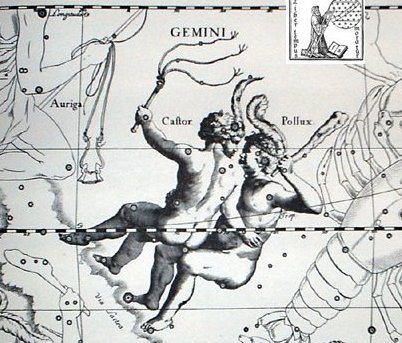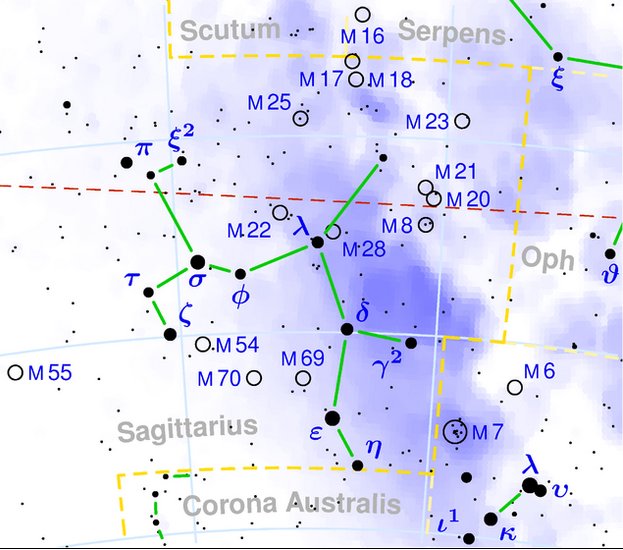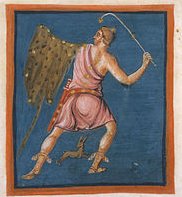I therefore suggest the beginning of line Cb4 corresponds to the beginning of a new year (or maybe 'year'), i.e. to the beginning of a.new 'Land'. South of the equator a year ought to be described as a pair of halves, because down south it is not the Sun but the Moon who defines the seasons. Half a year (177 + 1 days) after the beginning of the Gregorian year a new 'year' ought to begin:
The 'whip' stars (ψ1 - ψ9 Aurigae) - or rather those 9 ψ stars in Castor's Cat o' 9 tails - are scattered from June 25 and the heliacal rising of Canopus to Alhena (γ Gemini, the illuminated left foot of Pollux) in July 3:
Possibly a goat hide whip (februa) was a necessary instrument in the night in order to bring time running again (similar to the goad for making an elephant move). ... Februa, also Februatio, was the Roman festival of ritual purification, later incorporated into Lupercalia. The festival, which is basically one of Spring washing or cleaning (associated also with the raininess of this time of year), is old and possibly of Sabine origin. According to Ovid, Februare as a Latin word which refers to means of purification (particularly with washing or water) derives from an earlier Etruscan word referring to purging. The Roman month Februarius ('of Februa', whence the English February) is named for the Februa/Februatio festival, which occurred on the 13th to 15th days of this Roman month. A later Roman god Februus personified both the month and also purification, and is named for them. Thus, the month is named for the festival and not for the god ... ... At the beginning of 44 B.C. - when Ceasar was still alive - the Senate decided to raise statues of him in all the temples and to sacrifice to him on his birthday in the month Quintilis, which in honour of him was renamed July. He was raised to the status of a god (among the other gods of the state) under the name Jupiter Julius. Marcus Antonius, who this year was consul together with Ceasar, became high priest and responsible for the ceremonies. In the middle of February, at the time of the old feast of Lupercalia, he ran around naked (except for a girdle) ... and whipped the Roman ladies with thongs made from goat-skin, in order to promote ... their fertility ...
The old rule seems to end here. Al Batain 13 is June 25 and 6 * 78 (the synodic cycle of Mars) = 468. Henua at Sirius cannot be visually connected with any of the earlier henua glyphs on side b, but maybe with that in Cb5-15 (although it is drawn 'once more'):
The Murzim manzil, ruled by Sirius, was beginning in August 4. In the night of July 1 the Eye of the Archer (Ain al Rami, ν Sagittarii) was close to the full Moon. Sun rose there in January 1, in day 260 of the nakshatra calendar.
Ain al Rami is the little star close to the ecliptic below π and ξ. From Ain (ε Tauri) to Ain al Rami there are 286.2 - 65.7 = 220½ days. When in the night of July 3 the stars Ascella and Nunki (ζ respectively σ Sagittarii) marked the end of 'Land' it could be concluded that Sun had reached the point where a new Land would begin. Possibly Metoro's te hakaua (making rain) and ua (rain) meant a happy season of rain was on its way. If he commented on the signs in the night sky, then he ought to have recognized the 5 nights from December 30 (364). The 2nd Ashadha nakshatra (Uttara Ashadha) was ruled by Ascella and Nunki. Alhena, where Sun was when Ascella and Nunki were close to the Full Moon, was according to 'some Arabic authority': "... with χ¹ and χ² or Orion, the Bow with which the Hunter is shooting at the Lion." (Allen) But we tend to see χ¹ and χ² Orionis as the top of Orion's Club, down in the Milky Way.
Anyhow, there could be different instruments for different purposes, a goad for making the 'Elephant' move, a whip for waking up the ladies in the night, etc. In order to make 'fire' (the 'Lion') return at each beginning of time a bow and arrow could have been necessary. | |||||||||||||||||||||||||||||||||||||||||||||||||||||||||||||||||||||||||||||||||||||||||||||||||||||||||||||||||||||||||||||||||||||||||||||||||||||||||||














